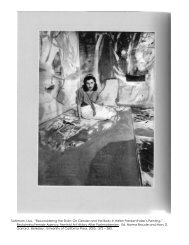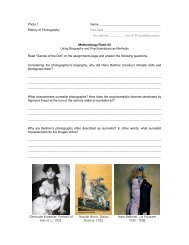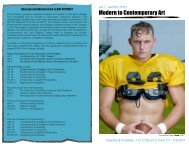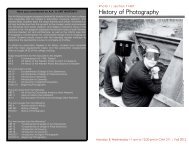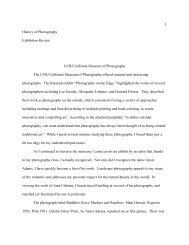Carte de California - the Slide Projector!
Carte de California - the Slide Projector!
Carte de California - the Slide Projector!
You also want an ePaper? Increase the reach of your titles
YUMPU automatically turns print PDFs into web optimized ePapers that Google loves.
<strong>Carte</strong> <strong>de</strong> <strong>California</strong>: Contested Terrain<br />
Two years after <strong>the</strong> discovery of gold at Sutter’s Mill, <strong>California</strong> entered <strong>the</strong> Union as a free<br />
state amidst great dispute, and only after concessions were ma<strong>de</strong> to appease pro-slavery<br />
Senators. The world turned its eyes to <strong>the</strong> western frontier, enticing a culturally diverse wave of<br />
immigrants, both American and international, to seek <strong>the</strong>ir own fortunes in this plentiful terrain.<br />
When <strong>the</strong> Civil War began a <strong>de</strong>ca<strong>de</strong> later, <strong>California</strong> was consi<strong>de</strong>red too remote to recruit<br />
soldiers or to ship supplies, but its fist-sized nuggets of gold would none<strong>the</strong>less prove <strong>de</strong>cisive in<br />
funding <strong>the</strong> Union Army’s eventual victory.<br />
Photographic technology quickly advanced concurrent with <strong>California</strong>’s Gold Rush, extending <strong>the</strong><br />
domain of <strong>the</strong> image profoundly. Popular carte-<strong>de</strong>-visite images (<strong>the</strong> term references formal<br />
cards used to announce <strong>the</strong> arrival of an aristocrat, and was appropriated to <strong>de</strong>scribe large<br />
format albumen photographs mounted on heavy card stock for durability and transport) and<br />
related stereo cards (two slightly offset images, also mounted on heavy stock, seen through<br />
hand-held <strong>de</strong>vices that produced a spectacular illusion of three dimensionality through binocular<br />
vision), were tra<strong>de</strong>d, collected, and prized for <strong>the</strong> novelty of <strong>the</strong>ir subjects, as well as <strong>the</strong><br />
encyclopedic knowledge <strong>the</strong>y offered through didactic texts printed on <strong>the</strong> reverse si<strong>de</strong>.<br />
Bolstered by Manifest Destiny doctrines that held westward expansion to be both inevitable as<br />
well as righteous, railroad barons beckoned “civilized” would-be settlers with carte-<strong>de</strong>-visite<br />
and stereo card landscapes teeming with splendor to <strong>de</strong>velop a terrain that was un<strong>de</strong>rstood to<br />
be “virgin,” and ”untouched.”<br />
At <strong>the</strong> end of <strong>the</strong> Civil War, with its gol<strong>de</strong>n sunshine and fertile promise, <strong>California</strong> as imagined<br />
through photographs seemed <strong>the</strong> perfect place for <strong>the</strong> nation to begin anew. Interested<br />
<strong>the</strong>mselves in new subjects through which to gain profit and notoriety, photographers set out on<br />
harrowing journeys to photograph <strong>California</strong>’s seemingly indistinguishable resources.<br />
Photographs of this era tell us that beyond its beauty and arid climate, <strong>California</strong> was a place<br />
full of wealth in <strong>the</strong> form of gold, silver, lumber, oil, fertile land, and native peoples that were<br />
ready for <strong>the</strong> taking. More than Three Hundred Years after <strong>the</strong> exploits of <strong>the</strong> Spanish<br />
Conquistadors, <strong>the</strong>n <strong>the</strong> Catholic missionaries, <strong>the</strong> history of this place was disregar<strong>de</strong>d and<br />
reinvented through photographs.<br />
Relics of <strong>the</strong> Spanish Conquest and Manifest Destiny politics can be seen in our landscapes to this<br />
day. Your travels to and from <strong>the</strong> Cal Poly campus will likely ring familiar in Jeff Cain’s work,<br />
where <strong>the</strong> artist follows <strong>the</strong> trail of invasive mustard seed planted by <strong>the</strong> Spanish as <strong>the</strong>y<br />
traveled north. A painful metaphor for <strong>the</strong> plight of <strong>the</strong> indigenous peoples who once thrived on<br />
this land but were forced into in<strong>de</strong>ntured servitu<strong>de</strong> at <strong>the</strong> missions, killed by European diseases,<br />
or slaughtered in officially sanctioned genoci<strong>de</strong>s, <strong>the</strong> opportunistic and poisonous mustard weed<br />
has overtaken <strong>California</strong>’s native, beneficial plant species like a scourge. The <strong>de</strong>ceitfully cheerful<br />
yellow flowers that now blanket <strong>California</strong>’s hillsi<strong>de</strong>s during <strong>the</strong> spring, will dry up in <strong>the</strong> summer,<br />
and make <strong>the</strong> perfect incendiary.<br />
Likewise, Julie Shafer’s pinhole negatives investigate <strong>the</strong> scars inflicted on <strong>the</strong> landscape through<br />
bellicose mining techniques used to strip every ounce of mineral of any worth from <strong>California</strong>n<br />
soil. Shafer traveled with her room-sized camera obscura to extraordinary sites like Malakoff<br />
Diggins (where mountainsi<strong>de</strong>s were intentionally washed away, leaving in <strong>the</strong>ir wake toxic plains
and unruly sludge) and Owens Valley (<strong>the</strong> dry lake created when Los Angeles diverted water<br />
from <strong>the</strong> Owens River). Her titles make wry remark on <strong>California</strong>’s state slogan, “Eureka,” which<br />
means, “I have found it!” Shafer’s photographs question who is <strong>the</strong> “I” who claims, and at what<br />
cost to those who do not own, and are left unrecor<strong>de</strong>d? The ghosts of <strong>the</strong> O<strong>the</strong>r haunt Shafer’s<br />
human-scale images.<br />
Enid Baxter Bla<strong>de</strong>r fur<strong>the</strong>r examines <strong>the</strong> footprint of short-sighted gains and unbridled<br />
subterfuge evi<strong>de</strong>nt in cookie-cutter suburbs and abandoned commercial enterprise. Baxter<br />
Bla<strong>de</strong>r is drawn to forgotten sites where she reckons with landscapes transformed by cleverly<br />
named housing <strong>de</strong>velopments and quaint mega malls <strong>de</strong>signed to look historic, <strong>the</strong>n follows <strong>the</strong><br />
avarice that drove <strong>the</strong> most contested urban planning project of all time, <strong>the</strong> Los Angeles<br />
Aqueduct. The artist mixes <strong>the</strong> cold objectivity of scientific survey with <strong>the</strong> emotional history of<br />
<strong>California</strong>’s urbanity to critique <strong>the</strong> misuse of public trust and foretell <strong>the</strong> current economic<br />
collapse. Her work points us back to <strong>the</strong> strategies of carte-<strong>de</strong>-visite photographers, but cautions<br />
that monsters loom in <strong>the</strong> plastic backdrops now dotting <strong>the</strong> landscape.<br />
As well, Dee Williams travels <strong>the</strong> concrete jungles that feed <strong>California</strong>’s sunny fictions. Billboards<br />
call out to crumbling si<strong>de</strong>walks to buy, to want, to consume while monolithic headquarters<br />
simultaneously obscure and mirror, but never reveal. In <strong>the</strong> spirit of Robert Frank, <strong>the</strong> signs of<br />
American patriotism and economic vigor are dismantled by Williams’ astute lens. The<br />
Conquistador’s dreams of cities of gold and fountains of youth are ever present in <strong>the</strong> abundant<br />
reflective surfaces of <strong>the</strong> city - those fortunes always yet to be found by <strong>the</strong>ir inhabitants. In<br />
Williams’ photographs, <strong>the</strong> viewer sees <strong>the</strong> American Dream ragged and torn.<br />
Collectively, <strong>the</strong>se works explore <strong>the</strong> contemporary implications of <strong>California</strong>’s political<br />
machinations and strife, revealing <strong>the</strong> scars of plun<strong>de</strong>r in <strong>the</strong>ir wake. As much a call to action as<br />
revelations of <strong>the</strong> conquests, <strong>the</strong>se works ask us to recognize our role in <strong>the</strong> loot, and assume<br />
more sustainable and responsible consumption of <strong>the</strong> terrain. To extend Glen Creason’s point in<br />
Los Angeles in Maps (2010) to inclu<strong>de</strong> <strong>the</strong> photographed terrain, <strong>Carte</strong> <strong>de</strong> <strong>California</strong>: Contested Terrain<br />
asks us to un<strong>de</strong>rstand that all photographs are fictions that have “led us into <strong>the</strong> future with <strong>the</strong><br />
conviction that mere lines on paper can make a [state]... Having finally run up against its limits,<br />
both geographical and psychological, that [state] of <strong>the</strong> imagination waits to be remapped as<br />
<strong>the</strong> geography of <strong>the</strong> home.”




